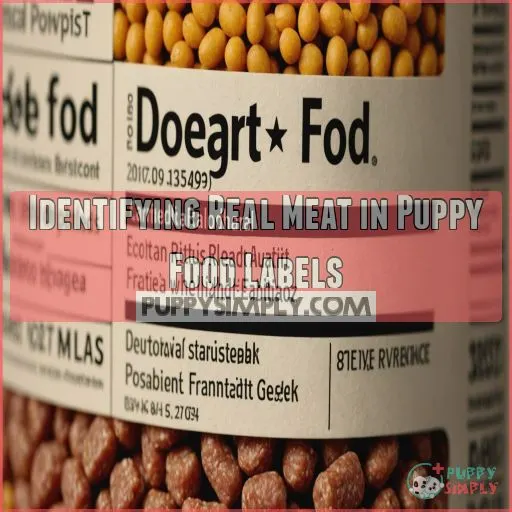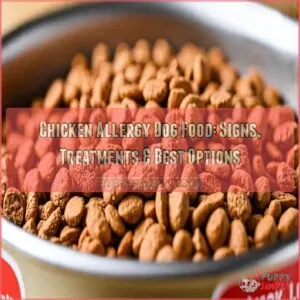This site is supported by our readers. We may earn a commission, at no cost to you, if you purchase through links.
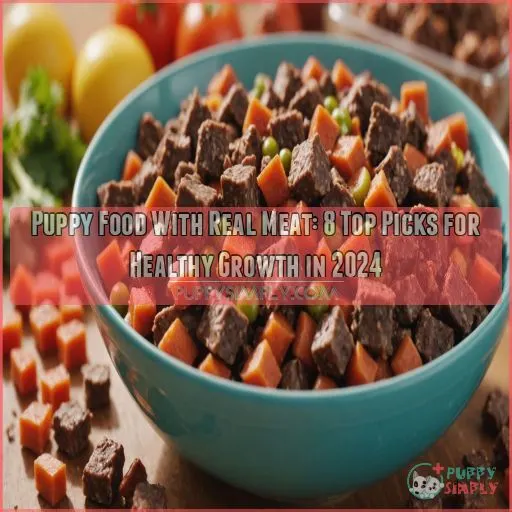
Real meat brings essential amino acids to the table, promoting muscle growth and a bouncy immune system. Unlike plant proteins, it’s easier for your puppy to digest, which means more nutrients and fewer tummy troubles.
With real meat, they’re more likely to dance around the kibble bowl, thanks to the taste and their inner wolf.
Wondering which puppy food hits the mark and how to spot quality meaty options on the label? Stick around for the full scoop on choosing the best.
Table Of Contents
- Key Takeaways
- Why Real Meat Matters in Puppy Food
- Identifying Real Meat in Puppy Food Labels
- Nutritional Needs of Growing Puppies
- Choosing Real Meat Puppy Food by Breed Size
- Fresh Vs. Dry Puppy Food With Real Meat
- Addressing Health Concerns With Real Meat Puppy Food
- Transitioning to Adult Food With Real Meat
- 8 Best Puppy Foods With Real Meat
- 1. Hill’s Science Diet Puppy Chicken & Rice
- 2. Purina Pro Plan Puppy Pate Chicken Rice
- 3. IAMS Smart Puppy Dry Dog Food
- 4. Royal Canin Small Puppy Dry Food
- 5. Purina Pro Plan Large Breed Puppy Food
- 6. Royal Canin Giant Puppy Dry Dog Food
- 7. Nutro Large Breed Puppy Chicken Rice
- 8. Beef Garden Veggie Dog Food
- Frequently Asked Questions (FAQs)
- Is real meat good for dogs?
- What is real meat dog food?
- What kind of dog food should a dog eat?
- Is just food for dogs good for dogs?
- What’S The BestDry Dog Food For Puppies?
- What is the healthiest meat for puppies?
- What age can puppies eat real meat?
- What fresh meat is good for puppies?
- What meat should puppies not eat?
- How do I file a pet food complaint?
- What are the AAFCO standards for pet food?
- How can I identify meat byproducts in pet food?
- What should I do if my pet has health issues?
- Where can I find a list of AAFCO-approved pet foods?
- Conclusion
Key Takeaways
- Choosing puppy food with real meat is like treating your pup to a five-star meal—it’s packed with essential amino acids for muscle growth and immune system support. Think of it as fueling their little engines with top-notch gasoline.
- Keep an eye out for labels that list specific meats, such as chicken or beef, as the first ingredient. It’s like being a detective; you want the real deal, not vague terms like "meat byproducts."
- Mixing up their meal routine with a combination of wet and dry food can be a win-win, providing wet food for hydration and taste, and dry food for their teeth. It’s like serving up a meal with a bit of balance and flair.
- Remember, not all pups are the same. Tailor their diet based on their breed and size, and watch them grow strong and healthy, just like nurturing a little plant with just the right sunlight and water.
Why Real Meat Matters in Puppy Food
Your puppy’s growth depends on the right fuel, and real meat packs the protein punch they need.
It’s not just about taste; real meat provides essential amino acids that support your pup’s development.
From building strong muscles to boosting their immune system.
Benefits of Real Meat for Puppies
Three cheers for real meat in puppy food.
It’s like hitting the nutritional jackpot for your furry friend. Real meat packs a punch for muscle growth, keeping your pup’s tail wagging with energy.
It’s not just about filling their belly; it’s about fueling their adventures.
Plus, it’s a boon for coat health, giving them that glossy, "just-stepped-out-of-a-doggy-spa" look.
Your pup’s immune system will thank you, too, due to the benefits of real meat in their diet, which supports their overall immune system health.
Protein Quality and Digestibility
You’ve heard about the benefits of real meat for puppies, but let’s chew on why protein quality and digestibility matter. It’s not just about having meat in the bowl; it’s about how well your pup’s body can use it. Think of it as the difference between a juicy steak and a tough piece of jerky for your furry friend.
- Animal proteins are generally more digestible than plant-based ones
- High-quality meat provides a complete amino acid profile
- Digestibility impacts nutrient absorption and overall health
- Specific meat sources (e.g., chicken, beef) are easier to identify on labels
Essential Amino Acids for Growth
Real meat isn’t just about digestibility; it’s a powerhouse of essential amino acids.
Your pup needs these building blocks for healthy growth, especially during those lightning-fast growth spurts (Source).
Think of amino acids as the Lego pieces of your puppy’s body – they’re constantly assembling and reassembling to support muscle development, tissue repair, and even immune function.
Without a complete set, your furry friend might hit a growth roadblock.
Palatability and Taste Appeal
Beyond providing essential amino acids, real meat in dog food delivers irresistible taste appeal. Your furry friend’s nose knows best!
- Natural instinct: Dogs are born carnivores, craving the rich flavors of meat.
- Aromatic allure: Real meat releases enticing scents that make kibbles more appetizing.
- Texture triumph: Meat adds a chewiness that keeps pups engaged.
Don’t be surprised if your pup does the "dinner dance" when you serve up real meat goodness!
Identifying Real Meat in Puppy Food Labels
You’ll need a keen eye to spot real meat in puppy food labels, but it’s worth the effort for your pup’s health.
Let’s crack the code on ingredient lists and uncover the meaty truth behind those fancy packaging claims.
Decoding Ingredient Lists
Ingredient list detective work is key to finding real meat in puppy food.
Don’t be fooled by fancy packaging; get into the details. Look for specific meat names at the top of the list, not vague terms like "meat byproducts" .
Remember, ingredients are listed by weight, so the first few are important.
AAFCO standards require at least 25% of named ingredients, but water content can skew percentages. Stay sharp, pet parents!
Whole Meat Vs. Meat Meal
When you’re sizing up puppy food labels, you’ll often come across two protein heavyweights: whole meat and meat meal.
Don’t let these terms throw you for a loop! Whole meat, like fresh chicken, packs a flavorful punch but contains about 70% water (Source).
On the flip side, meat meal is a protein powerhouse, boasting up to 65% protein after moisture removal.
It’s like comparing a juicy steak to beef jerky – both nutritious, just different!
AAFCO Guidelines for Meat Content
Now let’s talk about the meat and potatoes of puppy food labels – AAFCO guidelines.
You’ve got to be a real Sherlock Holmes to crack the code of ingredient lists! AAFCO standards are your trusty magnifying glass, helping you spot real meat in the puppy food jungle.
They set minimum percentages for protein sources and regulate how ingredients are labeled. It’s like having a nutrition detective on your side!
Nutritional Needs of Growing Puppies
Your growing pup’s body is like a high-performance engine, and real meat puppy food is the premium fuel it needs.
We’ll explore how to rev up your puppy’s health with the right balance of proteins, fats, and nutrients suited to their age and breed, and discover how to provide the best possible start with the right balance.
Protein Requirements by Age and Breed
Every puppy’s a protein powerhouse, but their needs aren’t one-size-fits-all.
Your furry friend’s protein requirements depend on their age, breed, and growth stage .
Small breed pups need energy-dense food to fuel their tiny turbo-charged bodies. Large breed puppies require a careful protein balance to avoid growing too fast (Source).
Aim for 22-32% protein on a dry matter basis for the best growth.
Balancing Fats and Carbohydrates
Balancing fats and carbs in your puppy’s diet is like walking a nutritional tightrope. You’ll want to hit the sweet spot for healthy growth without overdoing it. The fat-to-carb ratio is key for your pup’s energy needs and weight gain.
- Aim for 10-25% fat content on a dry matter basis
- Include at least 20% carbohydrates for energy
- Choose healthy fat sources like fish oils
- Vary carb types: brown rice, sweet potatoes, or oats
Vitamins and Minerals for Development
Vitamins and minerals are the unsung heroes in your puppy’s food bowl.
They’re like the backstage crew in a rock concert – you don’t see them, but they make the show happen.
Calcium and phosphorus build strong bones, while DHA supports brain development.
Iron and zinc? They’re the dynamic duo for a robust immune system.
Top puppy food brands pack these nutrients into their formulas, ensuring your furry friend grows up healthy and strong, like the high-quality protein formulas recommended for Goldendoodle puppies
.
Calorie Density for Energy Needs
Growing puppies are like furry little energy factories! They need high-calorie fuel to keep their tails wagging. Your pup’s food should pack a punch in the energy department. Think of it as premium gasoline for their growth engine.
- Kibble with 400-495 calories per cup is ideal for most pups
- Fresh foods can offer specific energy density for active pooches
- Large breed puppies may need lower-calorie options to prevent rapid growth
Choosing Real Meat Puppy Food by Breed Size
Choosing the right real meat puppy food for your furry friend isn’t one-size-fits-all—it depends on their breed size.
From tiny Chihuahuas to towering Great Danes, each pup has unique nutritional needs that’ll shape their growth.
So you’ll want to pick a formula that matches their size and future potential.
Small Breed Puppy Nutritional Needs
Your tiny tornado of a pup needs a power-packed menu. Small breed puppies burn through calories like there’s no tomorrow. They’re the high-octane sports cars of the dog world, needing frequent pit stops to refuel.
Choosing a breed specific puppy food formula that matches their size and lifestyle is essential for their growth and development. A specialized small breed food formula features a smaller kibble that’s easier for tiny mouths to chew, and also includes higher energy density to meet their rapid metabolism.
Let’s break down their unique needs:
| Nutrient | Why It Matters | Best Sources |
|---|---|---|
| Protein | Builds strong muscles | Real chicken, lamb |
| Fats | Fuels energy needs | Omega-3 from fish |
| Calcium | Supports bone growth | Balanced mineral mix |
| Antioxidants | Boosts immune system | Fresh veggies |
Remember, small doesn’t mean simple in terms of nutrition!
Large Breed Puppy Growth Considerations
While small breeds zip through puppyhood, large breed pups are marathon runners in the growth race.
Their bone development and joint health need special attention. You’ll want to keep an eye on those growth plates and manage their weight carefully.
Real meat puppy food for large breeds should have controlled calcium levels to prevent bone issues. It’s like building with the right materials and a steady pace – the right materials.
Breed-Specific Formulas With Real Meat
A buffet of breed-specific formulas awaits your pup, each made to fit your furry friend’s unique needs, from kibble size to protein content.
Let’s sniff out why they’re the cat’s meow:
- Large breed puppy food packs a punch with controlled calcium for healthy joints
- Small breed formulas offer concentrated nutrients in tiny, tooth-friendly bites
- Meat source impacts flavor and nutrition, so choose wisely for your picky eater
Remember, one size doesn’t fit all in the doggy dinner world!
Fresh Vs. Dry Puppy Food With Real Meat
You’re faced with a choice: fresh or dry puppy food with real meat.
Each option has its pros and cons.
From the convenience of kibble to the nutritional benefits of fresh food, but both can provide your growing pup with the high-quality protein they need for healthy development.
Pros and Cons of Fresh Puppy Food
A bowl of fresh puppy food tempts even the pickiest eaters, but is it worth the hype? Let’s chew on the pros and cons:
| Feature | Fresh | Dry |
|---|---|---|
| Nutrition | Higher nutrients | Varies by brand |
| Convenience | Requires refrigeration | Shelf-stable |
| Cost | Premium price tag | More budget-friendly |
Fresh food can boost digestive health and coat shine, but it’ll take a bigger bite out of your wallet. Remember, kibble‘s still a tail-wagging option for many pups!
Benefits of Air-Dried Real Meat Formulas
Air-dried real meat formulas are a game-changer for puppy nutrition.
This innovative process preserves nutrients without high heat, offering the benefits of raw food with the convenience of dry kibble.
You’ll love the extended shelf life and improved digestibility.
Plus, these formulas retain more natural goodness, making them perfect for pups with sensitive tummies.
It’s like giving your furry friend a gourmet meal without the fuss of fresh food prep, offering the convenience of dry kibble with the benefits of raw food.
Kibble With High Real Meat Content
Kibble with high real meat content offers a convenient way to provide your pup with quality protein. Unlike air-dried options, these crunchy bits pack a meaty punch without breaking the bank.
Look for brands that list real meat as the first ingredient. A high protein content is essential for muscle development, so make sure the kibble you choose contains a well-rounded amino acid profile, which is vital for muscle growth.
For best results, prioritize nutrient timing and meal frequency, as suggested for puppy muscle development. You’ll want to compare the meat content across different kibbles to ensure you’re getting the best bang for your buck.
Remember, a well-fed puppy is a happy puppy!
Combining Wet and Dry Real Meat Options
Everyone’s talking about the dynamic duo of wet and dry puppy food! You’ll get the best of both worlds: kibble for dental health and wet food for hydration.
This combo offers texture variety, keeping your pup’s tail wagging at mealtime. It’s a win-win for digestive benefits and nutritional balance.
Plus, you can customize your pup’s meals like a pro chef, mixing flavors to satisfy even the pickiest eaters , which is a great way to achieve nutritional balance.
Addressing Health Concerns With Real Meat Puppy Food
Real meat puppy food can help address common health concerns like allergies, digestive issues, and joint problems.
You’ll find options designed to manage sensitivities, support healthy digestion, maintain ideal weight, and promote joint health in growing pups.
Allergies and Sensitivities to Certain Meats
While real meat is paw-some for most pups, some might bark up the wrong tree with certain proteins.
Food allergies can turn your furry friend’s tummy into a hot mess . Beef, chicken, and lamb are common culprits.
If your pup’s scratching like they’ve got fleas in a circus, it’s time to play food detective. Your vet can help sniff out the troublemaker and suggest novel proteins to keep your pooch’s tail wagging.
Digestive Health and Real Meat Diets
A pup’s tummy is like a finely-tuned engine, and real meat diets can be the premium fuel it needs.
You’ll find that high-quality protein aids digestion and supports gut health .
Look for foods with prebiotics and probiotics to keep your furry friend’s digestive system purring like a well-oiled machine.
If your pup has a sensitive stomach, consider air-dried options that are gentler on their system.
Weight Management With Protein-Rich Foods
Surprisingly, protein-rich puppy foods can be your secret weapon for weight management.
They’ll help your furry friend build lean muscle while keeping those extra pounds at bay.
It’s like giving your pup a gym membership and a personal chef rolled into one. Opt for recipes with a balanced fat-to-protein ratio, and don’t forget to adjust feeding amounts as your puppy grows.
You’ll be setting the stage for a lifetime of healthy weight and wagging tails.
Joint Health Support in Large Breed Formulas
For large breed puppies, joint health is no small matter. You’ll want to choose a formula that supports those growing bones and joints.
- Controlled calcium levels to prevent rapid growth
- Glucosamine and chondroitin for cartilage health
- Omega-3 fatty acids to reduce inflammation
- Balanced protein-to-fat ratio for steady growth
Remember, overfeeding is a big no-no. It’s like putting too much weight on a wobbly table – those growth plates need time to close properly!
Transitioning to Adult Food With Real Meat
You’ll know it’s time to switch your pup to adult food when they reach about 80% of their expected adult size, typically between 6 to 14 months depending on breed.
When you make the switch, keep the real meat content high to support your dog’s continued health and energy needs.
When to Switch From Puppy to Adult Food
The clock’s ticking on your pup’s puppy food days. You’ll need to switch to adult chow based on your dog’s breed size, not just age.
Small breeds mature faster, while large breeds take their sweet time. Keep an eye on your furry friend’s weight and activity level too.
Remember, puppy food is like rocket fuel – great for growth, but risky for adults.
Gradual Transition Methods for Digestive Health
Moving your pup to adult chow doesn’t have to be ruff.
A slow and steady approach keeps tails wagging and tummies happy.
Imagine you’re teaching your furry friend a new trick – it takes time and patience.
For a healthy digestive system, it’s important to remember that puppy food for digestive health should prioritize high-quality ingredients and a balanced nutrient profile.
Also, maintaining regular bowel movements is key to a puppy’s overall digestive health, so be sure to keep an eye on that.
- Mix 3/4 puppy food with 1/4 adult food for two days
- Go half-and-half for the next two days
- Serve 3/4 adult food with 1/4 puppy food for three days
Keep an eye on your pup’s "output" to make sure everything’s moving along nicely.
Maintaining Real Meat Content in Adult Diets
Your pup’s ready to graduate from puppy food. Keep that real meat content going; it’s a boon for active dogs and those with health issues. Mix up meat sources for long-term benefits, whether opting for kibble or fresh food.
| Option | Pros | Cons |
|---|---|---|
| Kibble | Convenient, Balanced | Processed |
| Fresh Food | Nutrient-Dense | Short Shelf Life |
| Homemade Mixes | Customizable Recipes | Time-Consuming |
Considering homemade recipes or a dog food delivery service can add variety and flavor
.
8 Best Puppy Foods With Real Meat
Finding the right food for your puppy’s growth doesn’t have to be a tough quest; it’s about knowing which ingredients support healthy development.
Let’s explore some top puppy foods featuring real meat that meet nutritional standards and keep your pup’s tail wagging with every Havanese meal options best dog food for Havanese
.
1. Hill’s Science Diet Puppy Chicken & Rice
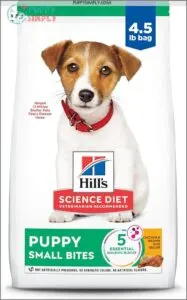 View On Amazon
View On Amazon If your puppy is a fan of chicken and rice, Hill’s Science Diet might just be a pawsome choice.
Enriched with DHA from fish oil, it supports brain and eye development. Plus, its high-quality protein aids in muscle growth while balanced minerals boost bone health.
Made in the USA, it’s highly recommended by veterinarians and loved by many puppies for its yum-factor.
Watch out, though—since puppies tend to gobble it up quickly, a slow feeder might be your best buddy!
Best For: This food is best for puppies who enjoy chicken and rice and need a balanced diet for growth and development.
- Supports brain and eye development.
- Provides high-quality protein for muscle growth.
- Veterinarian recommended.
- Some puppies may need kibble moistened.
- May require a slow feeder due to fast eating.
- May not be suitable for puppies with food sensitivities.
2. Purina Pro Plan Puppy Pate Chicken Rice
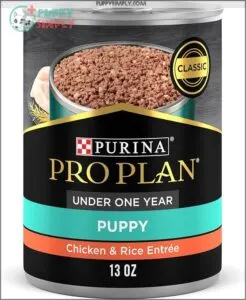
Consider the Purina Pro Plan Puppy Pate Chicken Rice as a hearty choice for your pup’s growth journey. Brimming with high-quality protein from chicken, it strengthens their muscles while the DHA aids brain and vision development.
The taste, often compared to human food, is a hit among pups, though some report digestive hiccups.
It’s crafted in the U.S. with a balanced nutrition profile, ensuring your puppy’s immune system gets the boost it needs. Who knew puppy chow could get so gourmet?
Best For: This pate is a good option for puppies transitioning to solid food or teething puppies.
- High-quality protein for lean muscle building.
- Supports a healthy immune system.
- Includes DHA for brain and vision development.
- Some puppies may experience digestive issues.
- The smell may be strong for some.
- May not be suitable for all puppies, especially older ones.
3. IAMS Smart Puppy Dry Dog Food
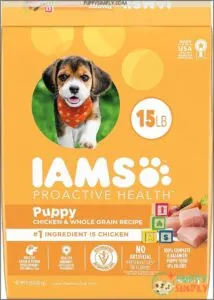
IAMS Smart Puppy Dry Dog Food is often a top choice for nurturing your puppy’s growth with high-quality protein sources, similar to nutritious puppy options
.
This kibble boasts chicken as the first ingredient, ensuring high-quality protein for developing muscles and a taste dogs love.
Plus, omega-3 DHA aids brain development, making pups more trainable. Think of it as getting your puppy ready for ‘obedience school’ with every bite.
You’re not just filling their bowl with this; you’re offering a balanced diet packed with 22 key nutrients found in mother’s milk.
Best For: IAMS Smart Puppy Dry Dog Food is best for puppies of all breeds from weaning to 12 months old.
- High-quality protein from chicken for growing muscles and a delicious taste.
- Contains omega-3 DHA for brain development and enhanced trainability.
- Provides a balanced diet packed with 22 key nutrients found in mother’s milk.
- Some customers have reported the price is a bit high.
- The delivery process has been reported as confusing, with shipments sometimes arriving in separate packages.
- The ingredients list contains some fillers like ground whole grain corn and sorghum.
4. Royal Canin Small Puppy Dry Food
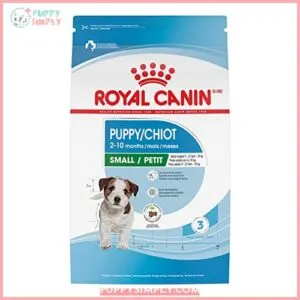
Why is Royal Canin Small Puppy Dry Food a top pick for healthy puppy growth, given its food sensitivities relief
?
This formula is designed for small breed pups from 2 to 10 months old, with an expected adult weight of 4.4-22 lbs.
It contains clinically proven antioxidants like vitamins E and C to support immune development, and is enriched with DHA to aid brain growth.
The small kibble size is designed for tiny jaws and picky eaters, while prebiotics and highly digestible proteins promote healthy digestion.
While some users note it’s pricey, many rave about their puppies loving the taste.
Ingredients and nutritional information for Royal Canin Small Puppy Dry Food.
User reviews and comments on Royal Canin Small Puppy Dry Food.
Additional user feedback and discussions around Royal Canin pet foods.
Best For: Small breed puppies from 2 to 10 months old, with an expected adult weight of 4.4-22 lbs.
- Supports immune system development with clinically proven antioxidants.
- Enriched with DHA to aid brain growth.
- Small kibble size is great for tiny jaws and picky eaters.
- Can be expensive.
- May be difficult to find in stores.
- Some users note that it is pricey.
5. Purina Pro Plan Large Breed Puppy Food

Purina Pro Plan Large Breed Puppy Food delivers growth support for your big, furry friend.
With real chicken as the first ingredient, this high-protein formula helps robust muscle development.
Plus, glucosamine aids joint health, perfect for those playful but clumsy puppy moments.
Vitamin A and omega-6 fatty acids keep skin and coat shiny, while DHA from fish oil boosts brain power.
It’s like giving your pup a superhero’s diet!
Though some find it pricey, the health benefits make it worth every penny.
Best For: Large breed puppies needing optimal growth and joint support.
- High-protein formula with real chicken for muscle development.
- Glucosamine for joint health and mobility.
- DHA for brain and vision development.
- Can be expensive.
- Some customers have reported difficulty finding it in stores.
- Packaging size and weight may be a concern for some.
6. Royal Canin Giant Puppy Dry Dog Food
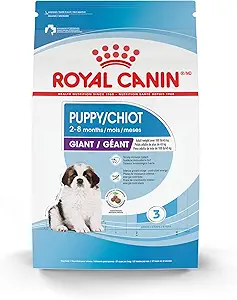
While big paws mean big appetites, Royal Canin Giant Puppy Dry Dog Food makes sure your puppy’s growth doesn’t go off the rails.
Specially crafted for future giants over 100 pounds, it supports brain development, gut health, and immune function with chicken by-product meal and brewers rice.
You’ll find peace of mind as this formula helps control excess weight while promoting healthy digestion and a shiny coat.
Some might grumble about the price, but many customers rave about their puppies thriving on it, making it a great choice for those seeking healthy digestion .
Best For: This food is best for large breed puppies (over 100 lbs at adulthood) between 2 and 8 months old.
- Supports brain development, gut health, and immune system
- Helps control excess weight gain
- Promotes healthy digestion and a shiny coat
- Some customers find the price to be expensive
- Contains chicken by-product meal, which some may find concerning
- May not be suitable for puppies with food allergies
7. Nutro Large Breed Puppy Chicken Rice
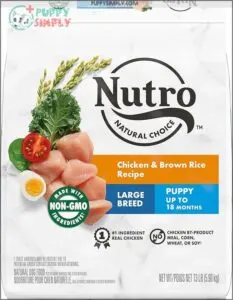
Is your large breed pup ready for real nourishment? Nutro Large Breed Puppy Chicken Rice is packed with real chicken as the first ingredient, supporting strong muscles and energy. Skip the fillers, as this blend contains no chicken by-product meal or artificial additives.
Genetics play a significant role in determining a puppy’s growth potential, but a well-balanced diet like Nutro Large Breed Puppy Chicken Rice, influencing growth rate, can help prevent developmental orthopedic diseases. Lower levels of phosphorus and controlled phosphorus levels in this food support strong and steady bone growth. It’s like giving your puppy a passport to healthy growth with DHA for brain and eye development.
Made in the USA from top-quality ingredients, this food makes sure your pup’s diet is as robust as their playful antics.
Best For: This is a great option for large-breed puppies who need a balanced diet with real chicken as the first ingredient.
- Made with real chicken, supporting strong muscles and energy.
- Contains no chicken by-product meal or artificial additives.
- Supports healthy brain and eye development with DHA.
- May contain trace amounts of corn, wheat, or soy protein due to potential cross-contact during manufacturing.
- Not suitable for puppies with sensitivities to chicken or other ingredients in the formula.
- Can be more expensive than some other puppy food brands.
8. Beef Garden Veggie Dog Food
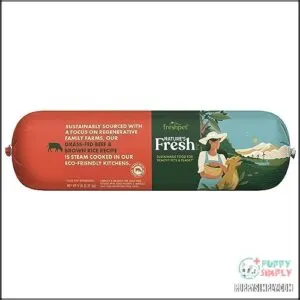
Beef Garden Veggie Dog Food is a pawsome choice for your furry companion, combining grass-fed beef with brown rice and veggies for balanced nutrition.
It’s steam-cooked to lock in nutrients and keep your pup’s tummy happy. Customers report that even picky eaters gobble this up.
Just remember, once opened, it should be used within 5 days, or you might face a sad puppy!
The high-quality ingredients make it pricey, but you’ll find it’s worth every penny when your pup thrives.
Best For: Picky eaters, dogs with sensitive stomachs, and owners looking for a high-quality, fresh food option.
- Steam-cooked to retain nutrients
- Made with humanely raised, grass-fed beef and brown rice & vegetables
- Many customers report their dogs love this food and see health improvements.
- Refrigerated and needs to be used within 5 days of opening.
- Can be expensive compared to kibble.
- May be hard to transition your dog back to kibble after trying this food.
Frequently Asked Questions (FAQs)
Is real meat good for dogs?
Dogs thrive on real meat, which provides essential proteins and amino acids for strong muscles and overall health.
It mirrors their natural diet, enhancing their energy and digestion.
Consider it the meat and potatoes of canine nutrition, which is really about providing them with foods that give them strong muscles.
What is real meat dog food?
Ever wondered what "real meat" in dog food means?
It’s meat like chicken, beef, or lamb sourced from trusted farms, often free-range or grass-fed, and packed with nutrients.
This helps your pup get a truly satisfying meal.
What kind of dog food should a dog eat?
You should select dog food based on your pet’s age, size, and health needs, ensuring it contains balanced nutrients like those found in a beagle homemade diet
.
Look for high-quality proteins, healthy fats, and essential vitamins to support their overall well-being and energy.
Is just food for dogs good for dogs?
Think of it like serving gourmet meals.
Just Food For Dogs offers high-quality, human-grade meals that support health through balanced nutrition.
With no preservatives and vet-approved recipes, it’s a solid choice for your dog’s wellness.
What’S The BestDry Dog Food For Puppies?
Finding the best dry dog food for puppies involves looking for options with real meat as the first ingredient.
Brands like Stella & Chewy’s offer good choices that balance convenience with nutrition, ensuring your puppy stays healthy.
What is the healthiest meat for puppies?
For pups who need a nutrient boost, chicken is a top choice.
It’s packed with lean protein and essential vitamins, giving them energy, muscle support, and a shiny coat.
This makes it a top choice for growing puppies.
What age can puppies eat real meat?
Puppies can start eating raw meat as early as 3-4 weeks old when they begin weaning off their mother’s milk.
However, it’s best to introduce new proteins gradually and make sure they get a balanced diet.
What fresh meat is good for puppies?
Imagine a dinner plate for a budding athlete.
Puppies thrive on raw meats like chicken, turkey, or fish, which are easy to digest.
Add a mix of organs and bone for balance.
Avoid fatty cuts.
What meat should puppies not eat?
Steer clear of feeding puppies raw or fatty meats like bacon or ham.
These can upset their stomachs or lead to pancreatitis.
Also, avoid bones and processed meats with high salt content, which can be harmful.
How do I file a pet food complaint?
In filing a pet food complaint with the FDA, gather details like the food’s brand, lot number, and your pet’s symptoms.
Submit this info via the online portal or contact local offices for support.
What are the AAFCO standards for pet food?
AAFCO sets pet food standards by defining nutrient profiles for different life stages, ensuring products labeled "complete and balanced" meet these requirements.
They don’t approve foods but establish guidelines for nutritional adequacy and feeding trials.
How can I identify meat byproducts in pet food?
Spotting meat byproducts in pet food is like finding the needle in a haystack.
Look for vague terms like "meat by-product" or "animal digest."
These indicate parts like organs or non-muscle meat.
What should I do if my pet has health issues?
When your pet has health issues, don’t wait—call the vet right away.
Early detection helps avoid complications.
Regular check-ups, a balanced diet, and exercise keep pets healthy and happy.
Remember, an ounce of prevention beats a pound of cure.
Where can I find a list of AAFCO-approved pet foods?
Choosing the right pet food can feel like a maze, but AAFCO’s got your back.
They have a wide-ranging list, so you can rest easy knowing your furry friend’s chow is top-notch.
Conclusion
Think of finding the right puppy food with real meat as giving your new buddy a superstar start in life.
With a focus on essential proteins and natural flavors, you’re setting them up for strong muscles and boundless energy.
Check out labels carefully, know your breed’s needs, and consider freshness in meal options.
By opting for real meat, you’re making a tasty yet nutritious choice your puppy will appreciate, wagging their tail through mealtime adventures.


